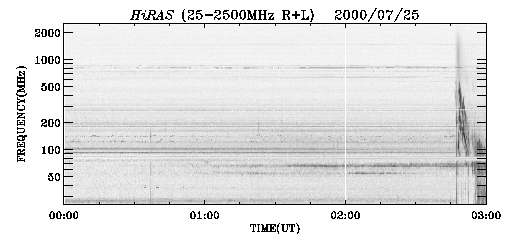
|

|
The solar corona, normally seething with activity but curiously stable on large scales, nevertheless undergoes sudden "restructurings". They provide the main range of topics for these science nuggets because of all the exciting and (frequently) inexplicable phenomena we see. Sometimes too a large-scale wave occurs, usually in consort with a restructuring event but sometimes not so obviously. We report on one here, an event of July 25, 2000, for which we got an alert from Culgoora, based upon which we found the plot below at Hiraiso. The Web makes this so easy! The occurrence of the Type II radio burst means that a large-scale shock wave has formed and has moved outwards through the corona, accelerating ambient particles as it goes.

|

|
The upper plot (Hiraiso's) shows the "dynamic spectrum" over the time and frequency ranges shown. The features drifting to lower right (starting at about 02:50 UT) plot mark coronal disturbances moving through a decreasing density (hence a decreasing plasma frequency), ie upwards through the corona and into the solar wind. The lower plot shows the GOES soft X-ray flux, with the not-coincidental peak marking the occurrence of a compact and rapid solar flare. Note that the rapidity marks this flare as not an "LDE" (Long-Decay Event), the kind best associated with restructurings in the form of coronal mass ejections and huge soft X-ray arcade features - see innumerable previous nuggets for examples (try entering "CME" in the SEARCH window at the bottom of the main page of this nugget archive).
The corona is an unusual place, since its structure is largely magnetic. Luckily for us it contains visible material too (or we couldn't see it!), but the basic mechanical quantities (forces and motions, including waves) all depend upon the B field. This makes the situation complicated, but intuitively it's not so bad as long as one bears in mind that the dispersion relation of the waves is not like that, say, of breakers at Bondi Beach.
Basically one can make a wave by creating a sudden disturbance, ie by moving something in the medium. The motion does not have to be supersonic (or its magnetic wave analog, "super-Alfvenic"), because the wave once launched will progressively steepen (like they do on Bondi Beach, actually) and become a shock. In the solar corona, there seem to be two possibilities. First, material can flow along the magnetic field lines, increasing the gas pressure. This increase can couple into MHD waves (a "pressure pulse"), and a wave could in principle form without restructuring. Second, the restructuring of the field associated with a flare or a CME can launch a wave. Actually, in the interplanetary medium, it is well-documented that solar ejecta can drive waves, continuously feeding them energy; in the corona the large-scale waves seem more like simple decaying waves, energized in one fell swoop.
If one thinks about it a little bit, in a high-beta plasma (B dominant), only a complex restructuring can occur: the forces available are an isotropic pressure term and a tension force along curved field lines. A motion could not be driven just by the pressure term, since it must arise from an equilibrium state. Thus the tension force has to do the dirty work via a dissipative (eg reconnection) or ideal (eg kink) instability.
We won't dwell on this, but in this case a notification from Simon Plunkett of SOHO, who is watching the coronagraph images all the time, remarked on the occurrence of a halo CME. In such a case brightening occurs all around the solar disk, ideally, implying that the disturbance was located near disk center. Close relationships exist among impulsive flares, Type II burst and halo CMEs.
So, did SXT see a pressure pulse or a restructuring? The answer is typically ambiguous and confusing, based on this quick look at some quite remarkable data! Clearly there's an ejection flying off to the SW (lower right):

These images come from the "half-resolution" SXT data, with 5 arc min field of view. Also, SOHO reported a halo CME. But... from the "quarter-resolution" SXT data, we don't see the X-ray ejection continuing. Instead it is a confined eruption, with abundant flow visible along the field lines. So we don't know - did these parallel flows act as a pressure pulse, or did the local restructuring? In any case the CME was not obvious in the SXT data, although interesting patterns of dimming remained; thus it probably did not play a role in the formation of the type II burst, whose Culgoora onset time (02:48 UT) occurred precisely in the middle of the four images shown above (as shown on the usual timing plot. A flare effect, for sure, and we are homing in on understanding the mechanism. Note that SXT only infrequently sees actual global waves (but see an earlier nugget); SOHO/EIT on the other hand seems to see them all the time. We are working on explaining this.
The ambiguity comes from the fact that in fact, yes, a pressure pulse does happen. Chromospheric gas fills a tiny loop system in a flare like this, just as the wave runs away; the picture below (2.6 arc min across; Be filter) perhaps shows both things:

It's a difference, as indicated, and the faint white features in the upper right are things blowing out - the dark wisps are where they had been. But the very bright white blob is the compact loop, whose pressure is increasing rapidly at this time. So we really can't easily distinguish between some sort of writhing MHD expansion (B only), and a pressure pulse (mainly gas). The good news is that we are seeing into the cores of these events and will probably figure things out because of this higher resolution. Check your science nuggets in the year 2001, for example...
July 28, 2000